
USS Arnold J. Isbell (DD-869), a Gearing-class destroyer, was the only ship of the United States Navy to be named for Arnold J. Isbell, an aircraft carrier captain during World War II. The ship was laid down on 14 March 1945 at Staten Island, New York, by Bethlehem Mariners Harbor, launched on 6 August 1945 and commissioned on 5 January 1946. Constructed too late to see action in World War II, the vessel initially served as a training ship with the United States Atlantic Fleet, before transferring to the Pacific and deploying to Korea during the Korean War and off the Vietnam coast during the Vietnam War. In 1972 Arnold J. Isbell was made part of the reserve training fleet and in 1974, sold to Greece where the ship was renamed Satchouris and served with the Hellenic Navy until being sold for scrap in 2002.

USS Stickell (DD-888) was a Gearing-class destroyer of the United States Navy. She was named for Lieutenant John H. Stickell USNR (1914–1943), who was killed in action at Jaluit Atoll in the Marshall Islands on 13 December 1943 and posthumously awarded the Navy Cross. She was renamed HS Kanaris (D212) on transfer to the Hellenic Navy in 1972.

USS Hawkins (DD-873) was a Gearing-class destroyer in the United States Navy during World War II. Following the war, the ship saw service in the Korean War and in the 1970s, was transferred to the Republic of China Navy as Tze Yang. She remained in service until the 1990s. The ship was then scrapped with the exception of her superstructure, which became part of a display and training ground at the Zuoying Naval Academy.

USS Duncan (DD-874) was a Gearing-class destroyer of the United States Navy, the third named for Captain Silas Duncan USN (1788–1834). The ship was laid down by the Consolidated Steel Corporation at Orange, Texas on 22 May 1944, launched on 27 October 1944 by Mrs. D. C. Thayer and commissioned on 25 February 1945. The ship was sunk in 1980.
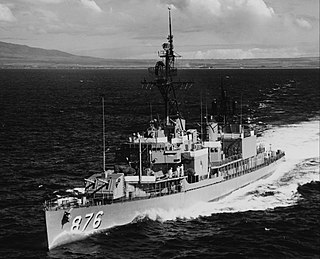
USS Rogers (DD-876) was a Gearing-class destroyer of the United States Navy. She was named for three brothers — Jack Ellis Rogers Jr., Charles Ethbert Rogers, and Edward Keith Rogers — killed in action aboard USS New Orleans during the Battle of Tassafaronga in the Solomon Islands on 30 November 1942.

USS Collett (DD-730) was a World War II-era Allen M. Sumner-class destroyer in the service of the United States Navy.

USS Halsey Powell (DD-686), was a Fletcher-class destroyer of the United States Navy.
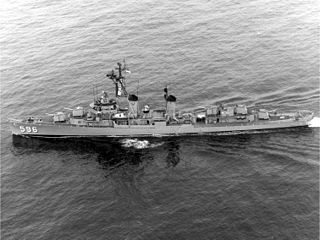
USS Shields (DD-596), was a Fletcher-class destroyer of the United States Navy.

USS John A. Bole (DD-755), was an Allen M. Sumner-class destroyer of the United States Navy.

USS John W. Thomason (DD-760), an Allen M. Sumner-class destroyer, is the only ship of the United States Navy to be named for John William Thomason, Jr., a USMC officer who was awarded the Navy Cross for bravery during World War I.
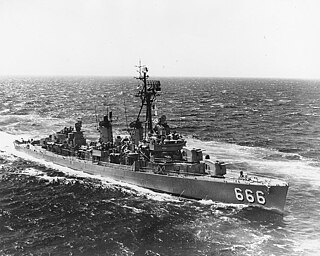
USS Black (DD-666) was a Fletcher-class destroyer of the United States Navy.

USS Hamner (DD-718) was a Gearing-class destroyer in the United States Navy during the Korean War and the Vietnam War. She was named for Henry R. Hamner.
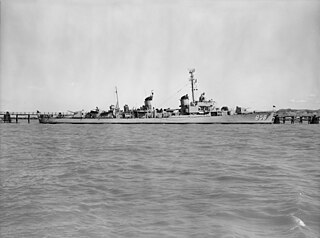
USS Fred T. Berry (DD/DDE-858) was a Gearing-class destroyer of the United States Navy.

USS George K. MacKenzie (DD-836) was a Gearing-class destroyer of the United States Navy, named for Lieutenant Commander George K. MacKenzie (1910–1943).

USS Gurke (DD-783) was a Gearing-class destroyer of the United States Navy, in service from 1945 to 1976. She was transferred to Greece in 1977 and served as Tombazis until 1997.

USS Henderson (DD-785) was a Gearing-class destroyer of the United States Navy, the second Navy ship of that name, and the first named for United States Marine Corps Major Lofton R. Henderson. The previous Henderson was named for Marine Corps Commandant Archibald Henderson.
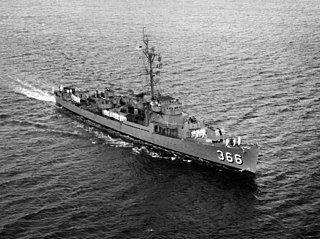
USS Alvin C. Cockrell (DE-366) was a John C. Butler-class destroyer escort in service with the United States Navy from 1944 to 1946 and from 1951 to 1968. She was finally sunk as a target in 1969.

USS Hanna (DE-449) was a John C. Butler-class destroyer escort acquired by the U.S. Navy during World War II. The primary purpose of the destroyer escort was to escort and protect ships in convoy, in addition to other tasks as assigned, such as patrol or radar picket. She returned home with five battle stars to her credit after she was reactivated for Korean War duty.
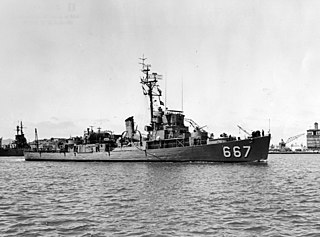
USS Wiseman (DE-667) was a Buckley-class destroyer escort in service with the United States Navy for several periods between 1944 and 1973. She was scrapped in 1974.

USS Horace A. Bass (DE-691/APD-124/LPR-124) was a United States Navy high-speed transport in commission from 1944 to 1969.






















